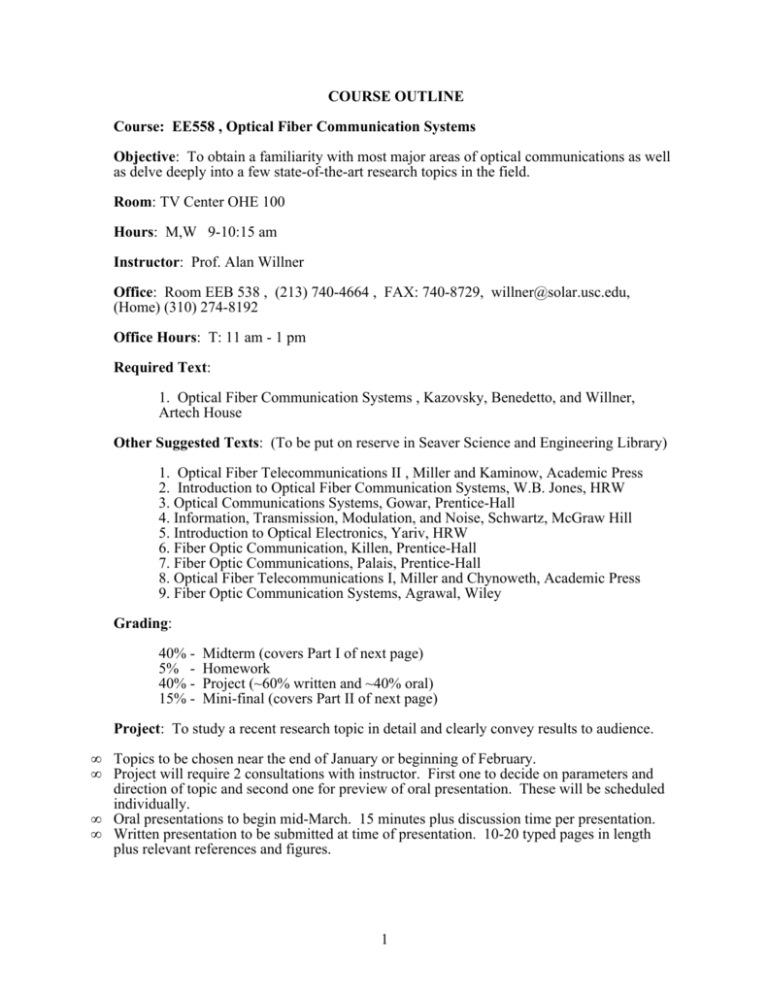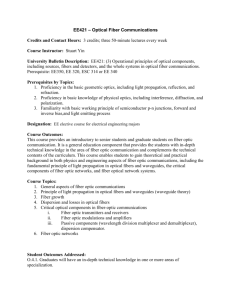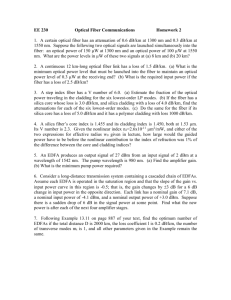Course Outline & Syllabus
advertisement

COURSE OUTLINE Course: EE558 , Optical Fiber Communication Systems Objective: To obtain a familiarity with most major areas of optical communications as well as delve deeply into a few state-of-the-art research topics in the field. Room: TV Center OHE 100 Hours: M,W 9-10:15 am Instructor: Prof. Alan Willner Office: Room EEB 538 , (213) 740-4664 , FAX: 740-8729, willner@solar.usc.edu, (Home) (310) 274-8192 Office Hours: T: 11 am - 1 pm Required Text: 1. Optical Fiber Communication Systems , Kazovsky, Benedetto, and Willner, Artech House Other Suggested Texts: (To be put on reserve in Seaver Science and Engineering Library) 1. Optical Fiber Telecommunications II , Miller and Kaminow, Academic Press 2. Introduction to Optical Fiber Communication Systems, W.B. Jones, HRW 3. Optical Communications Systems, Gowar, Prentice-Hall 4. Information, Transmission, Modulation, and Noise, Schwartz, McGraw Hill 5. Introduction to Optical Electronics, Yariv, HRW 6. Fiber Optic Communication, Killen, Prentice-Hall 7. Fiber Optic Communications, Palais, Prentice-Hall 8. Optical Fiber Telecommunications I, Miller and Chynoweth, Academic Press 9. Fiber Optic Communication Systems, Agrawal, Wiley Grading: 40% 5% 40% 15% - Midterm (covers Part I of next page) Homework Project (~60% written and ~40% oral) Mini-final (covers Part II of next page) Project: To study a recent research topic in detail and clearly convey results to audience. • • • • Topics to be chosen near the end of January or beginning of February. Project will require 2 consultations with instructor. First one to decide on parameters and direction of topic and second one for preview of oral presentation. These will be scheduled individually. Oral presentations to begin mid-March. 15 minutes plus discussion time per presentation. Written presentation to be submitted at time of presentation. 10-20 typed pages in length plus relevant references and figures. 1 EE558 COURSE OUTLINE I. Lectures on Major Areas of Optical Fiber Communications (~60% term) A. Component Issues 1. 2. 3. 4. 5. 6. Sources (LED and lasers) Fiber types and beam propagation Detectors and Receivers Connectors, couplers, isolators, polarization controllers Amplifiers, filters, modulators, and regenerators Optoelectronic integrated circuits B. System Issues 1. 2. 3. 4. 5. 6. Signal modulation formats and techniques Detection schemes Signal fidelity (signal-to-noise ratio and bit-error-rates) Optical switching (time-, wavelength-, and space-division-multiplexing) System topologies (bus, ring, star) and evolution (.86, 1.3, and 1.5 µm) Network considerations (circuit vs. packet switching, contention resolution, cost) II. Term projects on recent advances in Optical Fiber Communications (complete list to be distributed near the end of January) • • • • • • • • • • • Lasers : multiple-quantum-well, multi-electrode, micro-lasers, multiple-wavelength arrays, photonic-integrated-circuits Fiber : dispersion-shifted, polarization-preserving, pigtailing, splicing, packaging, integrated and monolithic couplers, fiber-Bragg gratings Filters : wavelength-tunable, fiber-Fabry-Perot, liquid-crystal, acousto-optic, wavelengthdivision multiplexers Receivers : high-speed, arrays, addressable, optoelectronic integrated circuits Amplifiers : semiconductor, Erbium-doped fiber, applications to long distance and distribution Optical Switching : electronic, space, time, and wavelength Long distance communications : amplifier applications, solitons, loop experiments, dispersion and nonlinearities Latest detection-scheme results : direct, heterodyne, homodyne Networks : time-, space-, code-, and wavelength-division-multiplexing, multi-hop, circuitand packet switching, contention resolution, FDDI Distribution systems : fiber to the curb and/or home, broadband integrated services digital network, network control, SONET and ATM standards Subcarrier multiplexing : FM, AM, digital, analog, cable-TV applications - Each project will deal with a subset of each topic heading - 2








